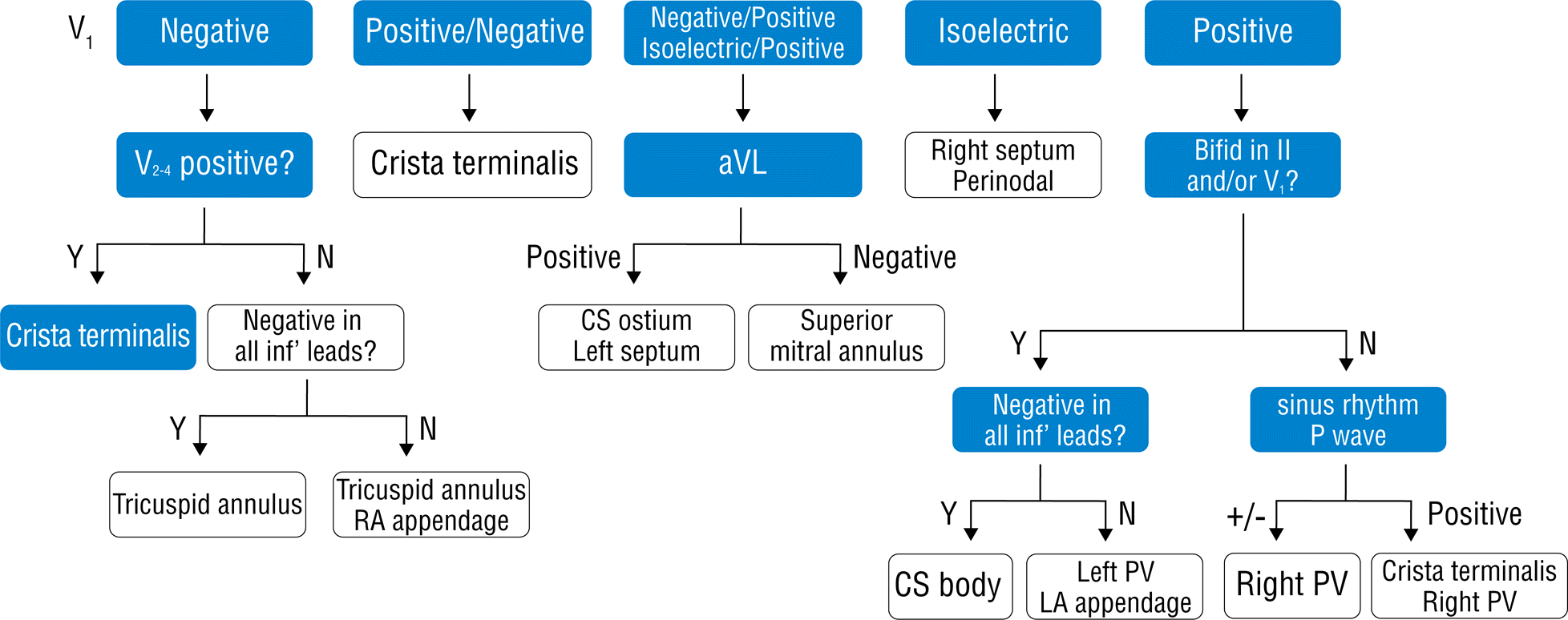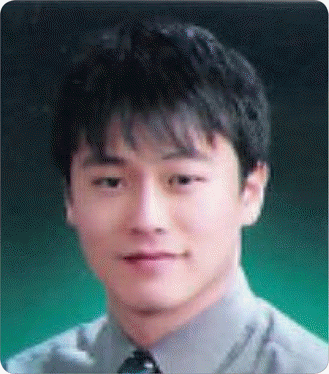비동성 국소성 심방빈맥
Abstract
Non sinus focal atrial tachycardia (AT) is an uncommon arrhythmia. Electrocardiograms (ECGs) can be used to diagnose the condition. ECGs can also be used to pinpoint the origin of the focal AT; however, the precise location is ultimately confirmed by electrophysiology. Automaticity, triggered activity, and microreentry are possible underlying mechanisms for focal AT. Pharmacological therapy is recommended for symptomatic patients. Radiofrequency catheter ablation is a viable alternative, especially in patients intolerant to drugs, or patients with drug-refractory focal AT. This review describes the epidemiology, clinical features, diagnosis, and mechanisms of focal AT, as well as possible therapeutic approaches for this condition.
Key words: Atrial Ectopic Tachycardia; Diagnosis; Therapy
서론
국소성 심방빈맥(focal atrial tachycardia)은 동방결절이 아닌 심방 부위에서 국소적으로 발생하여 원심성 방향으로 퍼져나가는 빠른 리듬의 부정맥이다. 대개의 경우 규칙적이나 빈맥의 시작 혹은 종료 시점에서 불규칙성을 보일 수도 있다. 국소성 심방빈맥은 심방의 활성화가 빈맥의 전 순환주기 동안 이루어지지 않는 특징을 보여 심전도 상에 P파와 P파 사이에 등전위성 분절이 관찰되며, 이러한 점은 대회귀성(macro-reentrant) 심방빈맥과 구별되는 특징이다 [ 1].
역학 및 증상
국소성 심방빈맥은 비교적 드문 질환으로 상심실성 빈맥으로 전기생리학 검사를 받은 성인 환자 중 약 5–15%를 차지한다 [ 2]. 국소성 심방빈맥의 인구학적 특성은 지속적으로 변하고 있는데, 이는 어린 연령에서 고주파전극도자절제술을 시행하는 경우가 많아지고 있기 때문이다. 증상의 시작은 어느 연령에서도 나타날 수 있으나 대개의 환자는 첫 증상을 10–39세에 경험한다 [ 3]. 국소성 심방빈맥 환자는 대개 구조적 심질환이 없는 경우가 많으나 심근병증, 심근경색과 동반하여 나타날 수 있으며, 저칼륨혈증, 저산소증, digitalis 독성과 연관되는 경우도 있다. 국소성 심방빈맥은 지속성 혹은 비지속성으로 나타나며, 비지속성 심방빈맥의 경우에는 대개 증상이 없으며, 치료가 필요하지 않다. 국소성 심방빈맥의 박동수는 대개 분당 130–250회이다 [ 4]. 성인에서 국소성 심방빈맥의 예후는 대개 양호하나, 멈추지 않는 상심실성 빈맥으로 고주파전극도자 절제술을 받은 환자 중 최대 10%에서 심방빈맥 매개성 심근병증이 관찰된 연구도 있다 [ 5].
진단 및 발생 기전
대부분의 국소성 심방빈맥은 12전극 심전도로 진단되며, P 파 모양으로 국소성 심방빈맥의 발생 부위를 추정할 수 있다( Figure 1) [ 6]. V 1 전극에서 양성 P파, I/aVL 유도에서 음성 P 파가 관찰되는 경우에는 좌심방에서 심방빈맥이 기원하는 경우가 대부분이며, II/III/aVF 전극에서 양성 P파가 관찰되는 경우에는 심방의 위쪽 부위에서 심방빈맥이 기원하는 것을 의심할 수 있다. 짧은 P파가 관찰되는 경우에는 좌/우 심방 free wall보다 심방중격 주위(paraseptal)에서 심방빈맥이 기원할 가능성이 높다. 국소성 심방빈맥의 발생 부위는 전기생리학 검사를 통해 확인할 수 있으며, 이 부위를 고주파전극도자절제술을 시행하여 성공적으로 치료하였을 때 최종적으로 확진할 수 있다. 최근 3차원 지도화 기법이 도입된 이후 보다 정확하게 발생 부위를 찾을 수 있게 되었다. 국소성 심방빈맥은 전 심방에서 무작위로 발생하기보다는 특정 부위에서 주로 발생한다. 이러한 특정 부위로는 crista terminalis (31%), 삼첨판막륜(22%), 폐정맥(19%), 관상정맥동(10%), 승모판막륜(4%), 좌/우 심방(1.2%), 좌/우 심방 free wall, 심방중격/방실결절 주변 부위(paraseptal/paranodal), 관상첨판(coronary cusp)이 있으며, 좌심방(27%)보다는 우심방(73%)에서 빈번하게 발생한다 [ 6].
Figure 1.
An algorithm for predicting the origin of focal atrial tachycardia according to P wave morphology.
CS, coronary sinus; inf’, inferior; LA, left atrium; N, No; PV, pulmonary vein; RA, right atrium; Y, Yes.

국소성 심방빈맥의 발생 기전은 자동능(automaticity), 방아쇠 작용(triggered activity), 소회귀(micro-reentry)로 나뉠 수 있다. 약물 검사, 전기생리학 검사를 통해 이를 구별할 수 있으나 민감도와 특이도가 낮아 제한적인 단점이 있다 [ 2, 7, 8]. 자동능에 의한 국소성 심방빈맥은 깊은 진정, 전신마취 하에서 부정맥을 유발하기 어려워 얕은 진정 상태에서 전기생리학 검사를 시행하는 것이 추천되며, programmed stimulation에 의해 유발/종료되지 않는 것이 특징이다. Isoproterenol에 의해 유발, adenosine/overdrive pacing에 의해 일시적으로 억제될 수 있으며, 베타차단제, diltiazem, verapamil에 의해서 종료될 수 있다. 방아쇠 작용에 의한 경우 adenosine/overdrive pacing에 의해 종료 될 수 있으며, 베타차단제, diltiazem, verapamil에 의한 반응은 다양하다. 소회귀에 의한 국소성 심방빈맥은 programmed stimulation에 의해 유발/종료가 가능하며, 진정 정도에는 별 영향을 받지 않는다. 그러나 adenosine, 베타차단제, diltiazem, verapamil에 대한 반응은 소회귀 회로의 위치에 따라 달라지는데, 만약 동방결절 주위에 소회귀 회로가 위치한다면 위의 약제에 의해 종료될 수 있으나 다른 부위에 위치한다면 종료되지 않는다.
치료
국소성 심방빈맥의 치료는 크게 급성기 치료와 만성기 치료로 나뉠 수 있다. 급성기 치료는 심박동수, 증상, 혈역동학적 안정성을 고려하여 치료해야 하며, 2015년 ACC/ AHA/HRS (American College of Cardiology/American Heart Association/Heart Rhythm Society) 진료지침에서는 각각의 상황에서 Table 1과 같이 치료를 권고한다 [ 1]. 현재까지 급성기 약물 치료 간의 유효성을 비교한 무작위 대조군 연구는 없다.
Table 1.
Recommendations for acute treatment of suspected focal atrial tachycardia
Class I
|
1. Intravenous β-blockers, diltiazem, or verapamil can be used for the acute treatment of hemodynamically stable patients with focal AT. |
2. Synchronized cardioversion is recommended for the acute treatment of hemodynamically unstable patients with focal AT.
|
Class Ila
|
1. Adenosine can be used in the acute setting to restore sinus rhythm in patients with suspected focal AT, or to diagnose the mechanism of the tachycardia.
|
|
Class llb |
1. Intravenous amiodarone can be used in the acute setting to restore sinus rhythm or slow the ventricular rate in hemodynamically stable patients with focal AT. |
|
2. Ibutilide may be reasonable in the acute setting to restore sinus rhythm in hemodynamically stable patients with focal AT. |
만성기 치료의 목표는 국소성 심방빈맥의 재발을 예방하고, 만약 재발하더라도 심박동수를 조절하여 증상을 완화시키는 것이다. 증상 발생의 빈도가 드물며 비지속성으로 나타나는 경우는 대개 치료가 필요하지 않으나, 빈번하게 발생하며, 증상이 있는 경우에는 치료가 필요하다. 약물 치료를 초기 치료로 고려할 수 있으나 성공률이 낮으며, 약제의 부작용이 있을 수 있다. 고주파전극도자절제술은 약물 치료에 반응하지 않거나 약물 치료를 할 수 없는 경우, 혹은 장기간의 약물 치료를 원하지 않는 경우에 적극적으로 고려할 수 있다. 고주파전극도자절제술의 성공률은 90–95% 정도로 우수하며, 합병증 발생 빈도는 1–2% 미만으로 안전하다 [ 2, 9– 11]. 2015년 ACC/AHA/HRS 진료지침에서는 만성기 치료를 Table 2와 같이 권고한다 [ 1]. 국소성 심방빈맥은 전신 색전증의 위험성이 낮기 때문에 심방세동과 심방조동이 동반된 경우가 아니라면 항응고 치료가 필요하지 않다.
Table 2.
Recommendations for ongoing management of suspected focal atrial tachycardia
Class I
|
1. Catheter ablation is recommended as an alternative to pharmacological therapy in patients with symptomatic focal AT.
|
Class IIa
|
1. Oral β-blockers, diltiazem, or verapamil may be used for the long-term management of patients with symptomatic focal AT. |
2. Flecainide and propafenone are effective options in patients without structural heart disease or ischemic heart disease who have focal AT.
|
|
Class IIb |
1. Oral sotalol and amiodarone may be used for the long-term management of patients with focal AT. |
결론
국소성 심방빈맥은 비교적 드문 질환으로 대개의 경우 심장질환을 동반하지 않는다. 증상이 있는 경우에는 치료가 필요하며, 약물 치료를 고려할 수 있으나 약물 치료에 반응하지 않는 경우 혹은 장기간의 약물 치료를 원하지 않는 경우에는 고주파전극도자절제술을 적극적으로 고려할 수 있다.
Biography
Yong-Giun Kim, MD
References
1. Writing Committee M, Page RL, Joglar JA, Caldwell MA, Calkins H, Conti JB, Deal BJ, Estes Iii NA, Field ME, Goldberger ZD, Hammill SC, Indik JH, Lindsay BD, Olshansky B, Russo AM, Shen WK, Tracy CM, Al-Khatib SM. 2015 ACC/AHA/HRS guideline for the management of adult patients with supraventricular tachycardia: a report of the American College of Cardiology/American Heart Association task force on clinical practice guidelines and the Heart Rhythm Society. Heart Rhythm 2016; 13: e136-e221.   2. Chen SA, Chiang CE, Yang CJ, Cheng CC, Wu TJ, Wang SP, Chiang BN, Chang MS. Sustained atrial tachycardia in adult patients. Electrophysiological characteristics, pharmacological response, possible mechanisms, and effects of radiofrequency ablation. Circulation 1994; 90: 1262-1278.   3. Rodriguez LM, de Chillou C, Schlapfer J, Metzger J, Baiyan X, van den Dool A, Smeets JL, Wellens HJ. Age at onset and gender of patients with different types of supraventricular tachycardias. Am J Cardiol 1992; 70: 1213-1215.   4. Roberts-Thomson KC, Kistler PM, Kalman JM. Focal atrial tachycardia I: clinical features, diagnosis, mechanisms, and anatomic location. Pacing Clin Electrophysiol 2006; 29: 643-652.   5. Medi C, Kalman JM, Haqqani H, Vohra JK, Morton JB, Sparks PB, Kistler PM. Tachycardia-mediated cardiomyopathy secondary to focal atrial tachycardia: long-term outcome after catheter ablation. J Am Coll Cardiol 2009; 53: 1791-1797.   6. Kistler PM, Roberts-Thomson KC, Haqqani HM, Fynn SP, Singarayar S, Vohra JK, Morton JB, Sparks PB, Kalman JM. P-wave morphology in focal atrial tachycardia: development of an algorithm to predict the anatomic site of origin. J Am Coll Cardiol. 2006; 48: 1010-1017.   7. Engelstein ED, Lippman N, Stein KM, Lerman BB. Mechanism-specific effects of adenosine on atrial tachycardia. Circulation. 1994; 89: 2645-2654.   8. Markowitz SM, Nemirovksy D, Stein KM, Mittal S, Iwai S, Shah BK, Dobesh DP, Lerman BB. Adenosine-insensitive focal atrial tachycardia: evidence for de novo micro-re-entry in the human atrium. J Am Coll Cardiol 2007; 49: 1324-1333.   9. Ferrero de Loma-Osorio A, Diaz-Infante E, Macias Gallego A. Spanish Catheter Ablation Registry. 12th official report of the Spanish Society of Cardiology Working Group on electrophysiology and arrhythmias (2012). Rev Esp Cardiol (Engl Ed) 2013; 66: 983-992.   10. Kalman JM, Olgin JE, Karch MR, Hamdan M, Lee RJ, Lesh MD. “Cristal tachycardias”: origin of right atrial tachycardias from the crista terminalis identified by intracardiac echocardiography. J Am Coll Cardiol 1998; 31: 451-459.   11. Roberts-Thomson KC, Kistler PM, Haqqani HM, McGavigan AD, Hillock RJ, Stevenson IH, Morton JB, Vohra JK, Sparks PB, Kalman JM. Focal atrial tachycardias arising from the right atrial appendage: electrocardiographic and electrophysiologic characteristics and radiofrequency ablation. J Cardiovasc Electrophysiol. 2007; 18: 367-372.  
|
|














